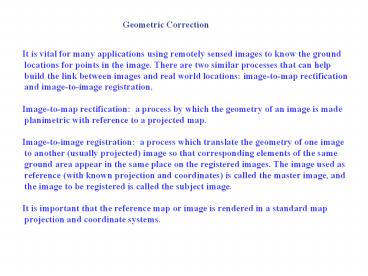Geometric Correction PowerPoint PPT Presentation
1 / 15
Title: Geometric Correction
1
Geometric Correction
It is vital for many applications using remotely
sensed images to know the ground locations for
points in the image. There are two similar
processes that can help build the link between
images and real world locations image-to-map
rectification and image-to-image
registration. Image-to-map rectification a
process by which the geometry of an image is
made planimetric with reference to a projected
map. Image-to-image registration a process
which translate the geometry of one image to
another (usually projected) image so that
corresponding elements of the same ground area
appear in the same place on the registered
images. The image used as reference (with known
projection and coordinates) is called the master
image, and the image to be registered is called
the subject image. It is important that the
reference map or image is rendered in a standard
map projection and coordinate systems.
2
Map Projection
Map projection is the process of systematic
transformation of points on the Earths surface
to corresponding points on a plane surface.
Cylindrical
Conical
Planar
3
Commonly Used Spheroid in Map Projection
Ellipsoids Date Semi-major axis
Semi-minor axis Ellipticity Clarke
1866 6,378,206.4 6,356,583.6
1/294.98 WGS72 1972 6,378,135
6,356,750 1/298.26 GRS80
1980 6,378,137
6,356,752 1/298.257 WGS84 1984
6,378,137 6,356,752
1/298.257
Many of the earlier US maps are based on Clarke
1866 ellipsoid which was determined by Sir
Alexander Clarke in 1866. The World Geodetic
System (WGS72 and 84) ellipsoids, determined from
satellite orbital data are considered more
accurate. GRS80 (Geodetic Reference System)
ellipsoid is adopted by the International
Association of Geodesy
4
The Global Coordinate System
spherical coordinate system unprojected!
expressed in terms of two angles (latitude
longitude) longitude angle formed by a
line going from the intersection of the prime
meridian and the equator to the center of the
earth, and a second line from the center of the
earth to the point in question latitude angle
formed by a line from the equator toward the
center of the earth, and a second line
perpendicular to the reference ellipsoid at the
point in question
5
Origin of Geographic Coordinate System
latitude positive in n. hemisphere negative in s.
hemisphere longitude positive east of Prime
Meridian negative west of Prime Meridian
Global Coordinate System
6
The Universal Transverse Mercator Coordinate
System
- 60 zones, each 6 longitude wide
- Starting from 180 degrees eastward
- zones run from 80 S to 84 N
- poles covered by Universal Polar System (UPS
7
UTM Zone Projection
Transverse Mercator Projection applied to each
6o zone to minimize distortion
8
UTM Coordinate Parameters
Unit meters Zones 6o longititue N and
S zones separate coord X-origin 500,000 m
east of central meridian Y-origin equator
9
USA In The UTM Zones
10
State Plane Coordinate System
Each state has one or more zones Zones are
either N-S or E-W oriented (except
Alaska) Each zone has separate coordinate
system and appropriate projection Unit
feet no negative numbers
11
Map Projections for State Plane Coordinate System
E-W zones Lambert conformal conic projection
N-S zones Transverse Mercator Projection
12
Geometric Correction
map
image
GCP
y
y
x
GCP
x
Ground Control Points
Master x Master y
Subject x Subject y
x1 y1 x2 y2
x3 y3
x1 y1 x2 y2
x3 y3
Note Coordinates must be in file coordinates
(lines, samples).
13
First order polynomial
Second order polynomial
Third order polynomial
Goodness of fit
Unit of RMSE pixels
14
Image Grids on Reference Grids
The output of geometric correction is a grid
that exactly overlays the reference grid.
Image-to-image registration Reference grids
already exist.
Image-to-map rectification Need to create a
reference grid first. (1). Specify an origin
(2). Translate map coordinates to image
coordinates based on pixel size.
15
Resampling Methods
- Nearest Neighbor The DN values in the output
grid takes from the pixel that - is nearest in the input grid. The output
grid maintains all the original DN values - in the input grid.
- 2. Bilinear Interpolation
Inverse distance weighted average of the four
nearest pixels to the output pixel.
3. Cubic Convolution
Inverse distance weighted average of the 16
nearest pixels to the output pixel.

